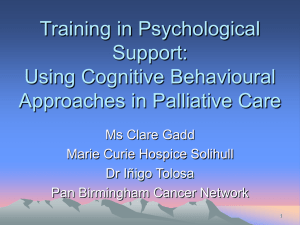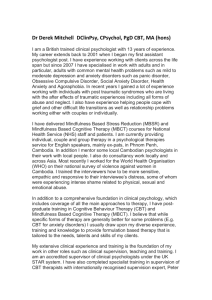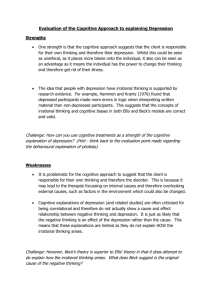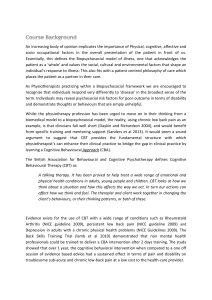Depression - University of Sussex
advertisement
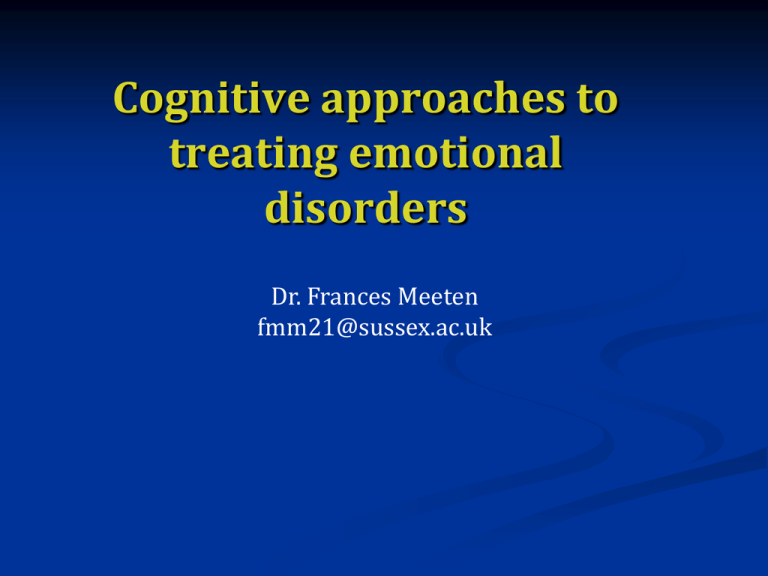
Cognitive approaches to treating emotional disorders Dr. Frances Meeten fmm21@sussex.ac.uk OVERVIEW: Learning outcomes - Understand two cognitive approaches to treating depression. The context of cognitive therapies in relation to other treatment options. Cognitive behavioural therapy (CBT) as a treatment for depression. Mindfulness based cognitive therapy (MBCT) as a treatment for depression. Treatment options DRUG THERAPIES Depression 1. Tricyclic drugs 2. Monoamine oxidase inhibitors 3. Selective serotonin reuptake inhibitors (SSRIs) PSYCHOTHERAPIES COGNITIVE BEHAVIOURAL THERAPY (CBT) PSYCHODYNAMIC MINDFULNESS BASED COGNITIVE THERAPY (MBCT) SYSTEMIC (FAMILY) Cognitive Behavioural Therapy (CBT) One of the most extensively researched forms of psychotherapy with over 325 outcome studies looking at CBT effectiveness published in 2006 (Butler et al., 2006). CBT encompasses a number of therapeutic cognitive and behavioural approaches. The compelling evidence base for CBT lead to an announcement in 2007 that there would be £173 million into an Improving Access to Psychological Therapies Program (IAPT) based on the finding that CBTs were more efficient than pharmacotherapy or other interventions (Rachman & Wilson, 2008). Depression Minor depression: Rumination on negative themes: Resentful, irritable, or angry Major depression: 5 or more symptoms in the last 2 weeks (Diagnostic Criteria (DSM IV) Major Depressive Episode) Emotional changes: feelings of sadness and hopelessness. Cognitive changes: low self esteem, guilt, concentration difficulties. Behavioural and motivational difficulties: feeling slowed down, reduced interest in social activities. Bodily changes: sleep, eating, loss of energy. Chronic depression occurs in 15-39% of cases with individuals still experiencing major depression one year after symptom onset (Berti, Ceroni, et al., 1984). Early experience • e.g. rejection and criticism from parents Negative core beliefs/schemas Beck’s cognitive model - Recap. From Dozois & Beck (2008) • I am incompetent Negative life event Activation of schema Cognitive biases • Nothing ever goes right for me Negative automatic thoughts Depression Structured: • Time limited • Problem orientated Role of therapist: • As a guide • As a scientist practitioner • Socratic method CBT STRUCTURE Cognitive techniques: • Hot cognitions Recording cognitions (mood diaries) • Identifying cognitive biases Behavioural techniques: • Behavioural experiments • Experiments with therapist • Experiments alone From: Westbrook, Kennerley, & Kirk (2007) Cognitive techniques Cognition: “either a thought or a visual image that you may not be very aware of unless you focus your attention on it” (Beck et al., 1979, p. 147) The C in CBT Help clients observe and record thoughts and images that run through their minds and help them to distinguish between thoughts and feelings. For example • Identifying ‘hot cognitions’: Rapid automated decisions based on significant emotions. • Identifying: ‘cognitive biases/ thinking errors’ Extreme thinking : Dichotomous thinking or unrealistic biases. Selective attention: Overgeneralization or disqualifying the positive. Example of techniques used to help people understand the link between thoughts and emotions Daily Thought Record Date & time Situation What mood were you in? How intense was the mood? 0 10 Not at all Very Thoughts Behavioural techniques/experiments The B in CBT Planned experimental activities, performed in or between cognitive therapy sessions. (Bennett-Levy et al., 2004) Their design is derived from a cognitive formulation of the problem and their primary aims are: 1. Test validity of clients existing beliefs about themselves, others, world. 2. Construct new, more adaptive beliefs. 3. Contribute to the development of the cognitive formulation. (Bennett-Levy et al., 2004) In depression, behavioural experiments may be used to test negative automatic thoughts and to re-evaluate underlying beliefs and assumptions. Behavioural experiments One example: Emma became depressed in university and dropped out when the pressure of exams became too much. She moved back to her parents’ house and felt too depressed to contact her friends. Hypothesis testing Theory A: Client’s initial belief: ‘My friends will think I am thoughtless and selfish and won’t want to know me’ - 80% belief. Theory B: Alternative belief: ‘One or two of my friends may be missing me, a couple have tried to contact me’ – 20% belief. Prediction: My best friend won’t want to know me any more. Even if we do meet I will probably feel foolish and cry all night. Outcome: After two more sessions working on the idea that the alternative belief may be true, Emma picked up the phone and rang her friend. Her friend was pleased to hear from her, they arranged to go out and Emma was surprised to find that she had fun and did not cry. Emma’s belief that her friend’s wouldn’t want to know her dropped to 10%. Common CBT goals 1.The client needs to counteract negative cognitive biases and develop a more balanced view of him/herself, the world, and the future. 2. Restore activity levels, especially of activities that bring a sense of pleasure and achievement. 3. Increase active engagement with problem solving. Efficacy of CBT for depression Based on clinical trials evidence – NICE recommends CBT for depression http://www.nice.org.uk/cg90 Important questions to consider when thinking about efficacy: 1. 2. What is CBT compared to? Drug treatments, other therapeutic approaches, nothing? Long term outcomes: Are treatment gains maintained over time? CBT is more effective than no intervention Based on meta-analysis of 97 studies, d = 0.67, Cuijpers et al., 2011 Is equally effective as other types of psychological therapy Based on meta-analysis of 56 studies, d = 0.03, Cuijpers et al., 2011 CBT is equally effective to antidepressant medication, and may be more effective at preventing relapse (De Rubeis et al., 2005) Efficacy of CBT for depression De Rubeis et al (2005) Study comparing cognitive therapy with antidepressant medication in adults No difference in outcomes at 16 weeks Cognitive Therapy was associated with lower rates of relapse Mindfulness Based Cognitive Therapy (MBCT) MBCT aims to prevent depressive relapse by developing awareness of and changing the relationship with unwanted negative thoughts, feelings and bodily sensations. In this way previously depressed individuals respond to negative thoughts not in an automatic way, but in a skilful intentional way. Ma & Teasdale (2004) Mindfulness “Paying attention in a particular way: on purpose, in the present moment , and nonjudgmentally ” Kabat-Zinn (1990) Core assumptions of MBCT MBCT assumes that once in a mode of recovery from depression, previously depressed individuals will still be vulnerable to experiencing low mood and patterns of negative thinking. Reactivation of depression related thoughts, feelings, and physical sensations is often automatic – and can trigger relapse. Model underlying development of MBCT for depressive relapse Negative thinking: Depressive episode Nonnegative thinking: Remission Potential RELAPSE Negative thinking patterns “nipped in the bud ” Negative thinking patterns re-established. From: Segal, Williams, & Teasdale (2002), p. 37 LOW MOOD Reactivation of negative thinking How does it work? “The aim of the program is freedom, not happiness” (Segal, Williams, & Teasdale, 2002, p.91) 8 week manualised course : Mindfulness practices and traditional cognitive therapy techniques AIM: To prevent re-establishment of patterns of negative thinking Core themes • Recognition of patterns of negative thinking e.g. ‘automatic pilot’ & ‘attachment to achieving happiness’. • How to step out of old cognitive routines e.g. ‘decentring & ‘mindful awareness’. • Experiential learning e.g. engaging in ‘being’ not ‘doing’ mode (in class and through homework. • Empowerment and acceptance/kindly awareness. Mindfulness practice In MBCT emphasis is placed on providing participants with opportunities to relate mindfully and directly to their experience – this is done through a series of meditation based exercises: • Body Scan • 3 minute breathing space • Mindfulness of the breath These practices teach how quickly the mind shifts from one topic to another and – having noticed that the mind is wandering, how to bring it back to a single focus. Once the participant becomes aware of normally unnoticed mind wanderings they use awareness to become vigilant of mood shifts either by acceptance (allowing them to be there in a non-judgemental way), or by employing a strategy to deal with negative thinking. (Segal, Williams, & Teasdale, 2002) Comparing MBCT and CBT Practical differences: MBCT delivered in a group format whereas CBT is often 1:1 MBCT is based on an 8 week program Theoretical differences: CBT encourages individuals to identify and change maladaptive thoughts by challenging the accuracy of their beliefs. MBCT teaches individuals to recognise the occurrence of depressive thoughts without emotionally responding to them. (Manicavasgar, Parker, & Perich, 2011) MBCT includes techniques and exercises from cognitive behavioural therapy with additional meditation components. (Segal, Williams, & Teasdale, 2002) Both MBCT and CBT include didactic elements, which provides the participants with information about depression to facilitate them in recognising and dealing with their relapse signatures. Is it effective? • NICE recommends MBCT for depressive relapse: http://www.nice.org.uk/cg90 • In individuals who had > 3 episodes of depression relapse was reduced when compared to TAU. (Ma & Teasdale, 2000, 2004) • MBCT shown to be more effective than m-ADM at preventing relapse. (Kuyken, 2008) • MBCT has shown promise for those still currently depressed or experiencing chronic depression. (Kenny & Williams, 2007; Kingston et al., 2007) MBCT Summary • MBCT aims to target relapsing depression and help people to stay well over the long term by changing the physical and psychological relationship with depression. • Integrates cognitive therapy principles and practice into a mindfulness framework. • Provides a structured 8 session program to foster a decentred relationship to experience. • Negative thoughts and feelings are viewed as events in the mind rather than ‘true’ statements about oneself. One size does not fit all! • The ‘alphabet soup’ of cognitive therapeutic approaches grows. • Cognitive therapy is intuitively attractive due to a large evidence base supporting its use, but some are unable or unwilling to engage. • How do we best deliver therapy? Will computerised packages become popular? • MBCT requires time, commitment, and the willingness to meditate. Summary • A range of cognitive approaches are available in the UK • CBT has one of the largest evidence bases Both cognitive and behavioural techniques help the individual to develop strategies for managing problems and guide the development of more adaptive perspective on the world. • MBCT has been developed to break the cycle of relapse common to depression Techniques teach individuals to be present, in the moment, to recognise negative thinking and decentre from it. Compassion and kindness to the self are fostered. References CBT • • • • • • • • • • • • • Bennett-Levy, J., Butler, G., Fennell, M., Hackmann, A., Mueller, M. & Westbrook, D. (2004) The Oxford guide to behavioural experiments in cognitive therapy. Oxford: Oxford University Press. Butler, A. C. Chapman, J. E. Forman, E. M. & Beck, A. T. (2006). The empirical status of cognitive-behavioral therapy: a review of metaanalyses. Clinical Psychology Review, 26, 17-31). Cuijpers P, Clignet F, van Meijel B, van Straten A, et al. (2011). Psychological treatment of depression in inpatients: a systematic review and meta-analysis. Clinical Psychology Review 31(3):353-60. DeRubeis, R. J., Hollon, S. D., Amsterdam, J.D., Shelton, R. C., Young, P. R., Salomon, R. M., et al. (2005). Cognitive therapy vs. medications in the treatment of moderate to severe depression. Archives of General Psychiatry, 62, 409-416. Dozois, D.J.A. & Beck, A.T. (2008). Cognitive schemas, beliefs, and assumptions. In K.S. Dobson & D.J.A. Dozois (Eds.), Risk factors in depression. London Academic Press. (Available online via ScienceDirect).(Nice explanations of main factors of cognitive model of depression) Rachman S, Wilson GT. (2008). Expansion in the provision of psychological treatment in the United Kingdom. Behaviour Research & Therapy, 46(3), 293-5. Westbrook, D. Kennerley, H. & Kirk, J. (2007). An introduction to Cognitive Behaviour Therapy: Skills and application. Sage. London MBCT Kenny, M. A., & Williams, J. M. G. (2007). Treatment-resistant depressed patients show a good response to mindfulness-based Cognitive Therapy. Behaviour Research and Therapy, 45, 617-625. Kingston, T., Dooley, B., Bates, A., Lawlor, E., & Malone, K. (2007). Mindfulness-based cognitive therapy for residual depressive symptoms. Psychology and Psychotherapy, 80 (2), 193- 203. Kuyken, W., Byford, S., Taylor, R.S., Watkins, E.R., Holden, E.R., White, K., Barrett, B., Byng, R., Evans, A., Mullan, E. & Teasdale, J.D. (2008). Mindfulness-based cognitive therapy to prevent relapse in recurrent depression. Journal of Consulting and Clinical Psychology 76(6), 966-978. Ma, S.H., & Teasdale, J.D. (2004). Mindfulness-based cognitive therapy for depression: Replication and exploration of differential relapse. Journal of Consulting and Clinical Psychology, 72, 31-40. Manicavasgar, V. Parker, G. & Perich, T. (2011). Mindfulness-based cognitive therapy vs cognitive behaviour therapy as a treatment for non-melancholic depression. Journal of Affective Disorders, 130, 138–144. Segal, Z.V., Williams, J.M.G., & Teasdale, J.D. (2002). Mindfulness-based cognitive therapy for depression: A New Approach to Preventing Relapse. New York: Guilford.




